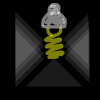Tronica
Well-Known Member
you guys my first grow i used a 400 watt hps and yeilded close to a pound
the strain was a bulky strain though
with a primo strain top of the line, you should get atleast 1 pound with a 600watt HPS
whats the most that can be yeilded by 600watts of CFL in any configuration?
honestly, no lieing
I got give big ups to Mr. Rosman as I got to this site through the stelath hydro website when i purchased CFLS for my first grow, i saw his review and searched your name on the internet and it led me to here.
that was like 2 years ago
anyway, i soon was convinced my cfls would not be enough and bought the 400watt hps mentioned above
so what is the best yeild u can get with 600watts of cfl?
cfls prove the best when combined in a mini-sog imo and a perpetual harvest.
so single harvest amounts aren't key really.
its harvest over time where cfls really shine.



